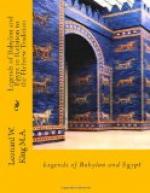The close parallel between the Sumerian and Babylonian Versions is not, however, confined to subject-matter, but here, even extends to some of the words and phrases employed. It has already been noted that the Sumerian term employed for “flood” or “deluge” is the attested equivalent of the Semitic word; and it may now be added that the word which may be rendered “great boat” or “great ship” in the Sumerian text is the same word, though partly expressed by variant characters, which occurs in the early Semitic fragment of the Deluge story from Nippur.(1) In the Gilgamesh Epic, on the other hand, the ordinary ideogram for “vessel” or “ship"(2) is employed, though the great size of the vessel is there indicated, as in Berossus and the later Hebrew Version, by detailed measurements. Moreover, the Sumerian and Semitic verbs, which are employed in the parallel passages quoted above for the “overwhelming” of the land, are given as synonyms in a late syllabary, while in another explanatory text the Sumerian verb is explained as applying to the destructive action of a flood.(3) Such close linguistic parallels are instructive as furnishing additional proof, if it were needed, of the dependence of the Semitic-Babylonian and Assyrian Versions upon Sumerian originals.
(1) The Sumerian word is (gish)ma-gur-gur, corresponding to the term written in the early Semitic fragment, l. 8, as (isu)ma-gur-gur, which is probably to be read under its Semitized form magurgurru. In l. 6 of that fragment the vessel is referred to under the synonymous expression (isu)elippu ra-be-tu, “a great ship”.
(2) i.e. (GISH)MA, the first element in the Sumerian word, read in Semitic Babylonian as elippu, “ship”; when employed in the early Semitic fragment it is qualified by the adj. ra-be-tu, “great”. There is no justification for assuming, with Prof. Hilbrecht, that a measurement of the vessel was given in l. 7 of the early Semitic fragment.
(3) The Sumerian verb ur, which is employed in l. 2 of the Fifth Column in the expression ba-an-da-ab-ur-ur, translated as “raged”, occurs again in l. 4 in the phrase kalam-ma ba-ur-ra, “had overwhelmed the land”. That we are justified in regarding the latter phrase as the original of the Semitic i-sap-pan mata (Gilg. Epic, XI, l. 129) is proved by the equation Sum. ur-ur = Sem. sa-pa-nu (Rawlinson, W.A.I., Vol. V, pl. 42, l. 54 c) and by the explanation Sum. ur-ur = Sem. sa-ba-tu sa a-bu-bi, i.e. “ur-ur = to smite, of a flood” (Cun. Texts, Pt. XII, pl. 50, Obv., l. 23); cf. Poebel, Hist. Texts, p. 54, n. 1.
It may be worth while to pause for a moment in our study of the text, in order to inquire what kind of boat it was in which Ziusudu escaped the Flood. It is only called “a great boat” or “a great ship” in the text, and this term, as we




